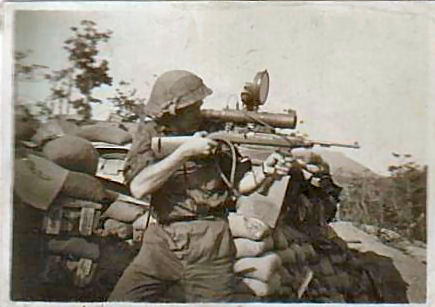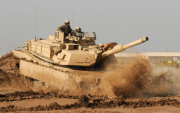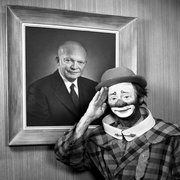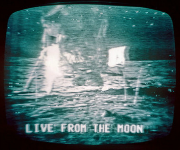|
brains posted:i'm not trying to say NVG and thermal imaging were invented in 1991, but there was a huge qualitative difference between the imaging systems on export T-55s and the imaging sensors on an Abrams, Not everyone had M1s. brains posted:and the Iraq armed forces (or any Soviet-equipped military of the time) definitely did not have the quantitative numbers of imaging systems fielded anywhere near what the US military had. nobody did, it wasn't even close. The Iraqis didn't have as many, but that's beside the point. As I said above, all of the NVGs in the world wouldn't have made a difference; it was air power that killed the Iraqi army. brains posted:and the sensors being fielded in the US in the late 80s/90s were most certainly cutting edge and cost a fortune, but the Regan-era US military was spending cash at incredible rates. No, they weren't cutting edge. The ANVVS-1/2 was at least a decade old. The M-36E1 went back to the mid-1970s. As far as portable NVGs the AN/PVS-5 was in use since the 1972. Some units had lots available, some didn't. Most combat/front line units had plenty. Personally I never paid for a set - I can believe they were expensive - but that didn't affect their availability. These weren't cutting edge and rare, they were decades old. Even if they were expensive, they were widely available. brains posted:you could argue that the US military's prowess at night fighting during the first Gulf War was even more revolutionary than the use of precision-guided weapons, which were actually quite limited in numbers during that campaign. No, sorry. We didn't really NVGs during the ground war itself. There was too much interference from the light from the oil fires. They may have been a great capability, but in my experience there weren't useful. Edit: Look, I'm not trying to be rude here, but you're making big statements that may have been true for some (Army troops in M-1s) but are directly contradicted by my personal experience. As with anything in History, the answer is "yes, but, it turns out it's more complicated." Cessna fucked around with this message at 17:41 on Mar 29, 2021 |
|
|
|

|
| # ? Apr 29, 2024 03:07 |
|
The high quality of Gen 3 NVDs and thermal sights were called out specifically as being a huge advantage by those who operated them in Desert Storm. It is a great example of a technowar win, regardless of what happened elsewhere during the campaign. LTG McMaster's last stop before the Trump fiasco was running the precursor to Futures Command; in that role he regularly used the sensor advantage his troops had at 73 Easting as a perfect example of what he wanted to do for the next generation. bewbies fucked around with this message at 18:15 on Mar 29, 2021 |
|
|
|
The first TI system I trained on was the colossally poo poo GW1-era Spyglass. I don't think having it would have made a lot of difference to the Iraqi army.  For that matter as Cessna says basic night vision is only occasionally better than just using your eyes.
|
|
|
|
bewbies posted:The high quality of Gen 3 NVDs and thermal sights were called out specifically as being a huge advantage by those who operated themin Desert Storm. It is a great example of a technowar win, regardless of what happened elsewhere during the campaign. Like I said, not everyone had M-1s. It's unsurprising that the army.mil page describes the US Army's experience, but they weren't the only ones there. I can believe there were great night vision devices in the M-1s out on the big "left hook" that went around Kuwait. Those of us who went into Kuwait itself, had decades-old stuff that wasn't useful due to the conditions on the ground. bewbies posted:LTG McMaster's last stop before the Trump fiasco was running the precursor to Futures Command; in that role he regularly used the sensor advantage his troops had at 73 Easting as a perfect example of what he wanted to do for the next generation. 73 Easting =/= the whole war. Cessna fucked around with this message at 18:19 on Mar 29, 2021 |
|
|
|
Yea 73 easting would not have ended differently BUT there wouldve been a lot of difference in casualty rated uf it wouldve been ”both sides can see eachother” versus ”lol wallhack” even if all the other, more important factors (navigation through desert, situational and command ability, armament and armor disparity, training level and dozen other factors) actually caused it to be as lopsided as it was. -a very simplified argument, effortposts have already been made-
|
|
|
|
Cessna posted:Like I said, not everyone had M-1s. It's unsurprising that the army.mil page describes the US Army's experience, but they weren't the only ones there. The original point was that 3rd Gen NVDs and thermals -- where employed -- were basically a cheat code, and it remains a great (and unanswered?) question why the Soviet bloc was so far behind in this area. And, to bring it back the point before that, everyone is terrified to some degree that we'll end up on the wrong side of the next generation's equivalent to Desert Storm AFV sensors, whatever that ends up being. Probably something with "computers."
|
|
|
|
Agreed. The Iraqis were totally and completely outclassed on every level. Personally speaking the Iraqis we rolled through were a desperate, shattered army with no ability to do anything beyond limited, local counter attacks. Even if they'd had the best night vision capability in the world it would not have mattered, because: (A) They had already been wrecked by air power. (B) NVGs didn't work in the conditions we were in.
|
|
|
|
bewbies posted:The original point was that 3rd Gen NVDs and thermals -- where employed -- were basically a cheat code, and it remains a great (and unanswered?) question why the Soviet bloc was so far behind in this area. Soviets were generally behind in microchip technology, I don't know if that is The reason but it can't have helped because these gadgets need microchips.
|
|
|
|
Nenonen posted:Soviets were generally behind in microchip technology, I don't know if that is The reason but it can't have helped because these gadgets need microchips. Earlier versions didn't. Like I said, there were early night vision devices in late WWII/Korea, well before the microchip was invented:  Obviously these early versions weren't as good as newer stuff, but I think it shows that some form of night vision doesn't require chips.
|
|
|
|
Cessna posted:Earlier versions didn't. Like I said, there were early night vision devices in late WWII/Korea, well before the microchip was invented: I know, even Nazis used this tech ('Uhu' or something). I was responding to the specific question of why Soviets had fallen behind in the technology coming to the 1990's. I don't know if the gap in microprocessors is the main reason for this but it doesn't seem to me like you could build a 3rd Gen thermal imaging system without them? Nenonen fucked around with this message at 18:45 on Mar 29, 2021 |
|
|
|
I’m not sure the Soviets ever fielded reliable thermal devices before they collapsed, and especially didn’t export any. I remember reading that some of the original units on Russian T-72Bs and T-80UMs were French. Different from NVGs for sure but a pretty important distinction for obscured combat conditions like they saw at 73. Night vision doesnt help you shoot through sand and smoke.
|
|
|
|
Cessna posted:Agreed. That's one of the reason why 73 Easting is such a useful benchmark -- it was an elite Iraqi division that was more or less at full strength and in a prepared defensive position that still got absolutely clowned on thanks in large part to sensor advantages (thermals in this case, less NVDs). Mildly interesting sidenote: you can trace a lot of the PLAA's modernization efforts straight back to their study of 73 Easting. That whole thing really grabbed their attention.
|
|
|
|
Nenonen posted:I know, even Nazis used this tech ('Uhu' or something). I was responding to the specific question of why Soviets had fallen behind in the technology coming to the 1990's. I don't know if the gap in microprocessors is the main reason for this but it doesn't seem to me like you could build a 3rd Gen thermal imaging system without them? I don't know, but it seems entirely reasonable that you'd need more processing power to make a more advanced device. It makes me wonder how they made any sort of night vision before even transistors were available.
|
|
|
|
Cessna posted:No, sorry. We didn't really NVGs during the ground war itself. There was too much interference from the light from the oil fires. They may have been a great capability, but in my experience there weren't useful. first hand experience is great from a history point of view! and it is a perfect example to show that on-paper capability does not mean every single unit has that capability available. however, consider that not every unit was fielded the same as you, and some units used their technological advantages to spectacularly exploit the enemy. also when i use the term fielded, i mean when a piece of equipment is operationally introduced to units, so the 1970s era NVS you were using was fielded in the 70s, and is most definitely not what i'm referring to. also, since we're doing this Cessna posted:73 Easting =/= the whole war. Cessna posted:Earlier versions didn't. Like I said, there were early night vision devices in late WWII/Korea, well before the microchip was invented:
|
|
|
|
brains posted:your personal experience =/= the whole war. it works both ways, just sayin' You were the one making claims about how the war went, not me. I pointed out that there were were major exceptions. brains posted:and the argument that WWII/Korean-era NVS were in any way comparable to the NVS and thermal sensors fielded to the US military in 1991 is pretty laughable. it is literally the core of the question at hand- why the top-line US sensors were so much more capable than the soviets at night fighting. there were advances needed in microprocessors, miniaturization, batteries, material sciences, and a whole host of other hard sciences to get to that level, serious research that the US spent a fortune on, but the soviets were not able to achieve parity, even though they developed many technologically advanced designs, and in some cases even more advanced than western equivalents, in other areas. You seem to be ignoring the part where I explain that night vision devices were useless due to the conditions on the ground and that airpower was far more important. Is this deliberate? I have no doubt that night vision systems were important - as I have said repeatedly - for the army units making the flanking left hook. But elsewhere they weren't used at all. Cessna fucked around with this message at 19:49 on Mar 29, 2021 |
|
|
|
WW2 Data Today marks the end of the coverage for the Czechoslovakian inventory with a final pair of 105mm cartridges, and a short bit of coverage on what Rockets or Pyrotechnics they may have had on hand. What differences exist between the packaging for both rounds? Do the Czechs have any rocket launchers at the time of the technical manual? What signal cartridges were available to them, and what domestic models exist and are used? All that and more at the blog!
|
|
|
|
Keep in mind that in the 1980s, the USSR was trying to upgrade their tank fleet with improved FCS (the "B" models of T-72, T-64, and T-80). The new model tanks were coming out, but they still had a huge fleet to replace and actual tank-usable IR sights are an incredibly expensive effort and still part of the next stage of upgrades which would've taken even longer. Given the limitations of their budget, going all in on improving their night optic capability just seems wasteful when most of your fleet still doesn't have laser rangefinders.
|
|
|
|
Once again the IJN was ahead of its time. First it was aircraft carriers as a crucial arm of the fleet, then it was specializing in night fighting. Unfortunately it is hard to pivot from night fighting at sea to night fighting on land. Spotlights probably are a mixed bag.
|
|
|
|
Argas posted:Once again the IJN was ahead of its time. luckily not in firefighting capabilities
|
|
|
|
bewbies posted:The US spends a TON of time and money and man hours pondering this stuff. Thank you, this is exactly the sort of thing I was wondering about! Also an interesting/helpful discussion of other examples, ty all.
|
|
|
|
Argas posted:Once again the IJN was ahead of its time. First it was aircraft carriers as a crucial arm of the fleet, then it was specializing in night fighting. Unfortunately it is hard to pivot from night fighting at sea to night fighting on land. US Navy: "We can use Radar to fight at night!" IJN: "What if binocular.... but B I G" SerCypher fucked around with this message at 04:04 on Mar 30, 2021 |
|
|
|
SerCypher posted:US Navy: "We can use Radar to fight at night!" We'll call them Dai-noculars
|
|
|
|
A good way to think of night vision generations is video encoding. A 1st gen starlight scope is like a 144p video, whereas a 3rd or 3rd+ gen is like a 360p or 480p and you can actually see stuff clearly. https://www.youtube.com/watch?v=MElDLRfd21o https://www.youtube.com/watch?v=TQ2zZhiWdds And current high-tech stuff is crazy: https://www.youtube.com/watch?v=8bTgG2Ft4xQ https://www.youtube.com/watch?v=c_0s06ORTkY
|
|
|
|
Argas posted:We'll call them To be fair one reason the IJN won big at Tsushima (or more so its aftermath) was better stereoscopic rangefinders, which equals longer effective firing range. That plus being faster is why the Russians flat out had to surrender because they would have been wiped out pointlessly otherwise.
|
|
|
|
C.M. Kruger posted:A good way to think of night vision generations is video encoding. A 1st gen starlight scope is like a 144p video, whereas a 3rd or 3rd+ gen is like a 360p or 480p and you can actually see stuff clearly. That colour NV is pretty cool. This is a few years old now but this kind of thing that gives the ability to uplink / downlink video, images and target data is a game changer for JTACs. The sight does TI and optical and you can get high accuracy grids for GMLRS missions etc as well. http://optronique.net/defense/wp-content/uploads/2012/07/FireStorm-Rockwell-Collins-brochure.pdf
|
|
|
|
SerCypher posted:US Navy: "We can use Radar to fight at night!" RN: "Say hello to my nighttime airstrike!"
|
|
|
|
Argas posted:We'll call them I think they were called 'Big Eyes' IRL so unironically yessssss.
|
|
|
|
Gort posted:luckily not in firefighting capabilities Not so lucky for them.
|
|
|
|
Another thing to keep in mind with regards to Desert Storm is that certain soviet equipment either didn't have trained operators needed to work, or wasn't engaged for some other reason. For example, we know that the Iraqi forces on paper had access to decent soviet jammers, but these weren't put into play. All that, though, is kinda moot with the amount of allied firepower coming in, as Cessna says.
|
|
|
|
Long time ago and I can't loving find them now but I read some accounts from Iraqi veterans and the impression I got was that they were never given even the on paper equipment or training. I'm sure there were some units that were but it sounded like for a lot of low level soldiers the emphasis was almost entirely on political loyalty. If somebody can find any such interviews that'd be great; my google results are all from the American side.
|
|
|
|
Tulip posted:Long time ago and I can't loving find them now but I read some accounts from Iraqi veterans and the impression I got was that they were never given even the on paper equipment or training. I'm sure there were some units that were but it sounded like for a lot of low level soldiers the emphasis was almost entirely on political loyalty. If somebody can find any such interviews that'd be great; my google results are all from the American side. I've told stories here about how woefully unprepared the Iraqis were.
|
|
|
|
SerCypher posted:I think they were called 'Big Eyes' IRL so unironically yessssss. The kawaii-est military technology
|
|
|
|
Are there any good, and recent academic articles/books/documentaries about the Persian Gulf War? I just spent some time searching Google and Amazon and it seems like it is now a forgotten war. A lot of the material I did find is in that 10 year period between the Gulf War and 9/11 when everyone's attention shifted. But I can't find much post-2003. It's weird to me to think of the Gulf War as a forgotten war, given it's enormous cultural impact as a kid growing up in the 90s. Or maybe its not that its forgotten, but the last 20 years of non-stop mid-east "forever wars" have significantly lessened its cultural impact in the West.
|
|
|
|
Solaris 2.0 posted:Are there any good, and recent academic articles/books/documentaries about the Persian Gulf War? WHICH ONE!?!
|
|
|
|
Nenonen posted:WHICH ONE!?! 1991 the one thats been discussed the last few posts. *edit* Is "The Persian Gulf War" still the official name of that war? There have been...a lot of wars in that region the last 30+ years. 
|
|
|
|
Solaris 2.0 posted:1991 the one thats been discussed the last few posts. I suspected so and sorry if my trying to sound funny came off as hostile, it's just a little peeve of mine that the Iran-Iraq war was the original Gulf War, then the Kuwait war thing started being called that, then people started calling the 1990 and 2003 wars Gulf War 1 and 2, respectively. And in all of the conflicts very little actually happened in the Persian Gulf itself! WHAT'S THE LOGIC 
|
|
|
|
Solaris 2.0 posted:I just spent some time searching Google and Amazon and it seems like it is now a forgotten war. It seemed like a big deal at the time.
|
|
|
|
Nenonen posted:I suspected so and sorry if my trying to sound funny came off as hostile, it's just a little peeve of mine that the Iran-Iraq war was the original Gulf War, then the Kuwait war thing started being called that, then people started calling the 1990 and 2003 wars Gulf War 1 and 2, respectively. Oh no I get it, that's why I'm legitimately wondering if "Persian Gulf War" is still the correct name for it. Anyway it's a war that's always fascinated me because it felt like the peak of US diplomatic and military power being used while it's Cold War adversary is literally disintegrating. But it's hard finding modern write ups about it. Searching Amazon at first glance there isn't much. And the only documentary I can find of note is a PBS Frontline documentary from 1995. To agree with Cessna it was a huge deal at the time. One of my earliest memories is watching CNN with my parents while Baghdad gets lit up with tracers the night the aerial war started. I was far too young to understand what was happening, but its a memory I still have.
|
|
|
|
I feel like Desert Storm kinda became shorthand for the 1991 affair at least in the US.
|
|
|
|

|
| # ? Apr 29, 2024 03:07 |
|
I think the name commonly used is "the Gulf War"
|
|
|



































 Yes, it's like a lava lamp.
Yes, it's like a lava lamp.



